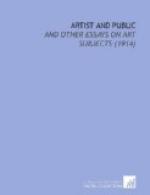His relations with Avet lasted from 1861 to 1864, when his master quarrelled with him and abruptly dismissed him from his shop. The boy was already a determined person; he believed that he had suffered an injustice, and, though Avet went to his parents and tried to induce them to send him back, he refused to return. A new master was found for him in the person of a shell-cameo cutter named Jules LeBrethon, and with him Saint-Gaudens remained three years. During his six years’ apprenticeship under his two masters the youth showed already that energy and power of will that made him what he was. He meant to be something more than an artisan, and he spent his evenings in the classes, first of the Cooper Union, afterward of the National Academy of Design, in the hard study of drawing, the true foundation of all the fine arts. It was one of the elements of his superiority in his profession that he could draw as few sculptors can, and he always felt that he owed an especial debt to the Cooper Union, which he was glad to repay when he modelled the statue of its venerable founder. Of the other institution by whose freely given instruction he had profited, the National Academy of Design, he became one of the most honored members. By 1867, when he was nineteen years old, he had saved a little money and was master of a trade that could be relied on to bring in more, and he determined to go to Paris and begin the serious study of sculpture. He worked, for a time, at the Petite Ecole, and entered the studio of Jouffroy in the Ecole des Beaux-Arts in 1868, remaining until 1870. During this time, and afterward, he was self-supporting, working half his time at cameo cutting until his efforts at sculpture on a larger scale began to bring in an income.




